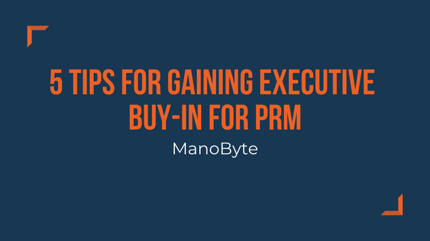
Technology can be a game-changer for your company. Often the needs, capabilities, and opportunities are well apparent to those working in the trenches but are not always as clear to senior leadership. Overcoming your boss’ objections to new technology platforms like a partner relationship management (PRM) platform can be daunting, but it’s doable.
Here are some tips for securing executive buy-in to using a new PRM for your organization.
Tip #1: Focus on the Mission
Make sure when you’re presenting new technology that you don’t focus on the hype, but rather on how something like PRM aligns with the core corporate mission. Knowing what a new platform can do for your organization can help make the case.
For example, with PRM, you can talk about the role partner management plays in:
- Making it easier for partners to sell your products
- Increasing market share
- Increasing mindshare about your products with channel partners
Tip #2: Frame the Issue
Often, technology solutions are implemented in order to address a pain point the company is having. Framing the issue and defining the need for a new PRM can provide you with the right context that makes the persuasion that much more effective.
Be sure to contextualize the need within the organization’s broader priorities, strategies, and abilities. Help executives visualize what the impact will be on the organization once a PRM solution is in place.
Among the key talking points to consider when presenting the argument for a PRM implementation are:
- The ability to plan and structure your PRM program within your broader channel strategy
- The value gained in recruiting and onboarding channel partners
- Better training and certification of your channel partners
- Improved communication to and from channel partners about your products, services, prices and customers
- Integration with other tools like customer relationship management (CRM) and enterprise resource planning (ERP)
- Enhanced co-branding, co-marketing and co-selling
Tip #3: Demonstrate Value
Executives can be reluctant to launch new initiatives for myriad reasons. Past experiences with costly overruns or ineffective results are one deterrent. A lack of true return on investment is another. Demonstrating the value and PRM cost benefits can help to mitigate those fears and get past any past blunders the organization has seen.
A PRM can directly impact the bottom line in a positive way. Be sure to point out the following:
Improved Workflows
PRMs can transform workflows that are outdated or manual processes related to communications, opportunity tracking, incentives management, or certifications. Streamlining these workflows via automation, data analytics, and smart, shared management processes helps to make the entire organization more efficient.
Scalability
As your partner program grows, you need tools that can scale accordingly. One way to do so is to have a powerful software tool that can grow as your channel partner program expands.
Personalization
No two channel partners are alike. By personalizing the experience for your partners, you reduce the need for manual, repetitive adjustments to content, information, pricing or reporting.
Segmentation
Your company needs to try different incentives and messages to spur response. With segmentation and targeting tools in your PRM, you can activate dormant partners and add more sales.
Tip #4: Cite the Data
Most C-suites are filled with leaders who want to see the data. What will the true impact be on sales and the bottom line? Be sure to have examples of other places where a PRM has made an impact on companies, especially those that are in your own line or work or a similar one.
Next, consider how the new technology will impact each facet of the organization, with data to back up your narrative.
Tip #5: Offer an Action Plan
Your action plan is critical. Be sure to lay out the anticipated resources, including personnel and dollars, to launch a PRM. Determine what intersections are necessary with existing business systems. Lay out as specifically as possible the organization’s commitment.
In creating this schematic, be sure to be transparent. Underselling the needs at the front end can only cause trouble as the project progresses. Also, help to show the impact of the PRM on every part of the channel partner lifecycle, including:
Infrastructure
What is the database schematic, security, pricing, and information necessary for your channel partner program?
Planning
Creating and managing a channel partner program is complex. A PRM helps simplify the planning at the product, company, region, and country levels. It also helps manage go-to-market approaches, coverage mapping, and capacity planning.
Contract Management
Here is where you can detail different partner types, compliance needs, payment schedules, and terms.
Performance Management
Performance models usually include incentives and rewards that incentivize performance at the partner and individual level. Use dashboards, reporting, and automation to improve how these critical communications functions operate.
Onboarding and Training
As new partners and salespeople come on board, you need an easy, consistent, and effective way to train them about your products and services, policies, compensation, training, and certification.
Content Management
With price lists, catalogues, diagrams, and fact sheets constantly being updated and revised, your company needs a way to manage content and deliver it accurately to content partners, something your PRM should provide.
Manobyte helps companies with technologies that accelerate digital transformation. Our solutions in channel partner management, sales enablement, marketing, and operations change the way companies do business and drive better outcomes. We help you build a streamlined, connected technology roadmap that creates a firm foundation and a plan for the future. To learn more, contact us today.


